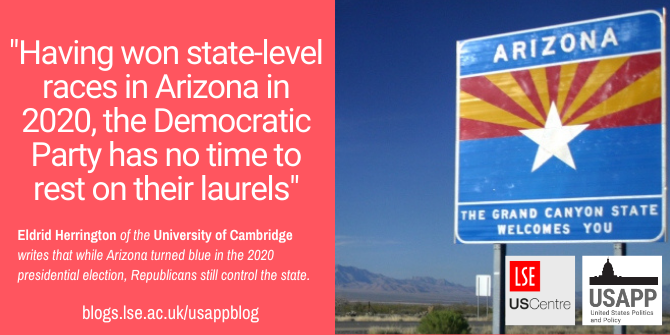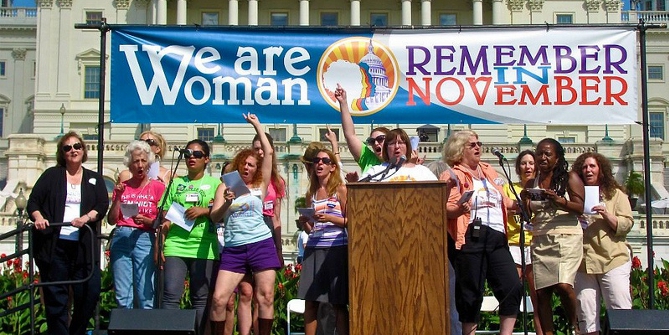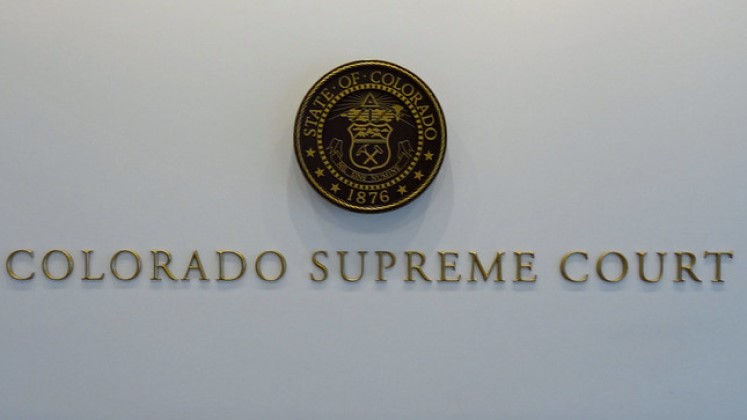Reflecting broader democratic shifts, recent decades have seen big changes in politics in Arizona: moving from deep red Republican domination to a particular shade of purple over the last decade. Eldrid Herrington maps how these changes have played out in recent years, the 2020 general election, and what they might mean moving forward.
- Following the 2020 US General Election, our mini-series, ‘What Happened?’, explores aspects of elections at the presidential, Senate, House of Representative and state levels, and also reflects on what the election results will mean for US politics moving forward. If you are interested in contributing, please contact Rob Ledger (ledger@em.uni-frankfurt.de) or Peter Finn (finn@kingston.ac.uk).
At 2.14pm on the 6th of January 2021, as Congress’ conducted its ceremonial Electoral Vote count, Paul Gosar of Arizona was addressing the US House of Representatives, challenging the electoral votes in his own state, when he and his colleagues had to be rushed out of the chamber and taken to safety elsewhere in the Capitol building. Hours later, when the legislature returned, almost all Republican representatives from Arizona persisted in repeating the lie that their party did not, in fact, lose the elections in the state (excepting, presumably, their own races).
Arizona Republicans might feel that it is they who are embattled. In 2016, the state voted for Donald Trump, had two Republican senators, and a Republican state legislature. In 2020, Arizona voted for a Democratic presidential candidate for the first time in almost 25 years, has two Democratic senators for the first time in almost 70 years, but also voted for one of the most deeply conservative Republican state legislatures in decades. How did Barry Goldwater’s state, the epicenter of deep red Republicanism, turn this particular shade of purple?
Changing GOP fortunes
Republicans’ margin of victory has declined steadily over the past few elections. In 2012, Romney won by a 12 percent margin. In 2016, Donald Trump won by a 3.5 percent margin. In 2020, Joseph Biden’s margin of victory was 10,500 ballots in a state with 4.28 million voters. The state remains majority Republican, but has an extremely large and longstanding proportion of independent voters: 1.5 million Republican (34.9 percent), 1.3 8million Democratic (32.5 percent), 1.36 million Independent (31.8 percent).
US Senate
1953 was the last time two Democratic senators served Arizona; one of them later lost to Barry Goldwater, who himself lost to Lyndon Johnson in the 1964 presidential race. In 2018, moderate Republican Jeff Flake chose not to run again. He had calculated that Republican politics in the state had shifted to the right and that he was likely to lose his own party’s vote. At the same time, moderate Republicans and independent voters had become disaffected with Trump and Democrats were highly energized against the president. Those voters chose Democrat Kyrsten Sinema (D) over air force veteran Martha McSally (R). When Senator John McCain died a few months later in 2018, McSally was appointed to his seat by Republican governor Doug Ducey.
In the special election of 2020, McSally again lost to Mark Kelly. His service as an astronaut and Navy captain persuaded many moderate Republicans. Perhaps most importantly, he is the husband of former Arizona Congresswoman Gabrielle Giffords, who was shot and severely injured in 2011. Her longstanding commitment to politics and particularly gun violence prevention has been an integral part of Kelly’s campaign, which he will have to reprise in two years’ time. Sen John McCain’s widow, Cindy McCain, endorsed Biden and also Kelly, a crucial endorsement for persuading moderate Republicans. Since the events in the Capitol, the Arizona Republican Party has taken revenge on her, proposing a “censure resolution” on a private citizen and maligning the service and character of her late husband. The Maricopa County (the most populated County in the state) GOP has censured Jeff Flake.
Arizona State Senate
These extraordinary GOP actions reflect the hard-right turn in the state: in 2020, Republicans increased their numbers in the state legislature and replaced many of the moderate Republicans in power. There is an ongoing struggle for the identity of Republicanism in Arizona. Even before the Capitol insurrection, Arizona Republican Party Chair Kelli Ward, US Representatives Gosar and Andy Biggs, chair of the right-wing Freedom Caucus in Congress, had turned their wrath on Republican Governor Doug Ducey and state Representative Rusty Bowers, Republican and House Speaker. Ducey’s chief of staff, Daniel Scarpinato, has called Biggs “nuts” and a “permanent member of Crazytown”. Civility does not seem to be the order of the day in the Republicans’ near future.
While Arizona Republicans move rightward in discrete districts, the state as a whole has moved leftward. In 2020, local ballot propositions that were heavily labor backed have succeeded, including one that will increase public school funding through higher taxes on the top 4 percent of earners in the state.

Image: By Wing-Chi Poon [CC BY-SA 2.5], from Wikimedia Commons,
Voters
Recent years have seen large changes in the demographics, and thus the politics, of Arizona, with the state trending towards the Democrats and turning purple politically. Some of the most pronounced trends include:
Maricopa County
60 percent of Arizona’s voters – some 4.5 million – live in Maricopa County. Encompassing Phoenix, it is one of the fastest growing counties in the country, chiefly due to migration from neighboring states such as California, which has leaned more liberal, increasing Democratic vote margins.
White voters
There remains a large cohort of older white retirees whose mail in ballots broke strongly for Trump in 2020. However, the proportion of white men without a college education in the state has dipped by 5 percent since 2016. White women with a college education, who backed Trump (48 percent) over Clinton (46 percent) in 2016, changed their votes radically, backing Biden by 60 percent.
Latinx vote
There has been a 350 percent increase in the Spanish-speaking population in the past 20 years, from 365,000 in 2000 to 1.3m in 2020, representing 24 percent of eligible voters as against 13.3 percent nationally. 70 percent of these voted for Biden. Latinx voters tend to be majority Mexican American and skew young and progressive.
The reason for the progressivism is specific. In 2010, the Arizona legislature passed Senate Bill 1070 (SB1070), widely known as the “show me your papers” bill. It was aggressively enforced in ways that were found to be racial profiling by Sheriff Joe Arpaio, who was later convicted of criminal contempt of court. Trump pardoned him in 2017. There is lingering distaste for Arpaio, who is at once charismatic and cruel: his rapid rise to power and prominence was matched by an equally precipitous fall, evident in his extremely small vote share when he failed to secure the Republican primary for US Senate in 2018.
SB1070 spurred grassroots organizing and Arizona is now one of the most activist states for organizing alongside, notably, Nevada and Georgia. This is driven by issues such as SB1070 but also by the state’s substantial number of voters who identify as independent. Organizations critical to the 2020 Democratic win include Arizona Wins, Chicanos por la Causa, Four Directions, LUCHA, Mi Familia Vota, Mijente, the Rural Arizona Project, union organizations, Vets Forward, and Vote America.
In addition, the disproportionate and devastating impact of COVID-19 on Latino populations has spurred a repudiation of perceived failures in Republican approaches to public health.
Native American vote
According to a New York Times analysis, Biden’s narrow win was due in part to a 25 percent increase in the Native American vote in the state, from 41,500 in 2016 to 55,000, predominantly in the Navajo and Hopi nations but also in the Tohono O’odham nation, whose land has been cut and sacred sites destroyed by the border wall. The impact of COVID-19 has been devastating and the votes have also been seen as a repudiation of failed pandemic policies.
Black Lives Matter
The police shooting of Dion Johnson, 28, on May 25th 2020 while he was asleep in a car in Phoenix, brought Arizonans out in protest in the streets and a surge in organizing and political engagement.
Other constituencies have also been seen as contributing to the Democratic win, such as the overseas vote.
What’s next for the Grand Canyon State?
Having won state-level races in Arizona in 2020, the Democratic Party has no time to rest on their laurels, and not just because Mark Kelly has another election in 2022. Their presidential and US Senate successes were extremely narrow and are fragile in a state with an energized core of hard right supporters. The college educated white women voters who backed Trump in 2016 and then changed their minds might return to Republicanism in 2024. As in Georgia, successful political organizing has been conducted by grassroots organizations more than by the Democratic National Committee. Despite statewide successes, local races in suburban and rural districts have not turned Democratic, demonstrating a lack of down ballot traction. Increasing diversity in the largest county, Maricopa, cannot be guaranteed to deliver results for Democrats without strong voter engagement given a long history of non-party voter registrations and independent voters.
Please read our comments policy before commenting.
Note: This article gives the views of the authors, and not the position of USAPP – American Politics and Policy, nor the London School of Economics.
Shortened URL for this post: https://bit.ly/2Y1bGqU
About the author
Eldrid Herrington – University of Cambridge
Eldrid Herrington is a lecturer in English literature at Cambridge and a Senior Research Fellow in medicine at Queen Mary, University of London. She was recently a Visiting Fellow in history at Oxford.







Usually it is my impression that the English do not understand how Americans live or think. This short analysis does not support that impression. Perhaps I should rethink my opinion.
You have at least one typographical error in the article. The counting of the electoral votes occurred on January 6, 2021, not on January 6, 2020.
Hi John,
Thanks for spotting the typo, it’s now been corrected.
-Chris
Blog Editor, LSE USAPP
I personally believe Arizona will be a tossup state for the future. Mcsally was a 2 time loser if The AZ gop gets the right candidates for 2022 they can hold the governor race and retake a senate seat.
Republicans will be making a massive come back in 2022. The Democrat Party advantage from biased redistricting 10 years ago will disappear next election and maybe even benefit Republicans. In addition, this is a midterm election where the Democrats will do poorly. Finally, people now see how radical the Democrats are and how inept President Biden is, which will drive more people to vote Republican.
I am not a political person, but kudos to you for giving this kind of information because this enlightens me about what is happening in our country, especially in Arizona. Because of this, I was already aware that Arizona voted Democratic presidential candidate for the first time in almost two decades with two Democratic senators for the first time in nearly 70 years. How did Barry Goldwater’s state, the epicenter of deep red Republicanism, turn this particular shade of purple?